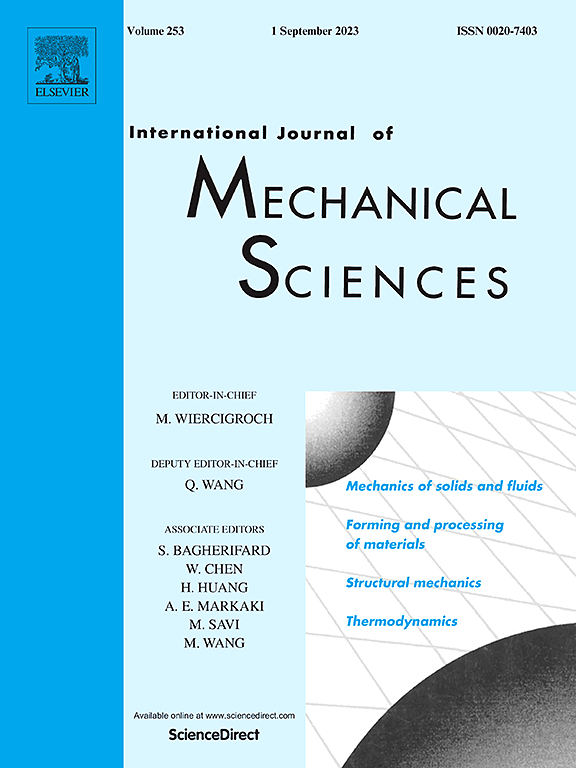以欧拉边界定义剪切区的加工残余应力模型
IF 7.1
1区 工程技术
Q1 ENGINEERING, MECHANICAL
International Journal of Mechanical Sciences
Pub Date : 2025-07-11
DOI:10.1016/j.ijmecsci.2025.110592
引用次数: 0
摘要
对切削残余应力优化与控制的要求越来越高,需要一种有效、准确的切削残余应力预测方法。为了解决这个问题,我们提出了一种基于任意拉格朗日-欧拉技术的新型混合模型。该模型模拟了二维和三维切削残余应力。它将初级和三级剪切区视为欧拉边界,允许在这些区域应用热机械载荷,并在不模拟切屑形成的情况下模拟材料去除。这减少了90%以上的模拟时间。最终的残余应力是利用特征应变理论从地下塑性应变计算出来的,从而消除了模拟释放或冷却过程的需要。实验测量也被纳入确定等效热机械负荷,进一步提高模型的准确性。通过与传统数值模型和实验数据的比较,证明了该方法在效率和精度上的优越性。值得注意的是,未切割的切屑厚度对尖端挤压的影响很小。相反,它主要通过改变原始剪切区载荷来影响残余应力。本文章由计算机程序翻译,如有差异,请以英文原文为准。

Machining residual stress model with shear zones defined as Eulerian boundaries
The increasing demand for the optimisation and control of machining-induced residual stress necessitates an efficient and accurate method for predicting the cutting residual stress. To address this, we propose a novel hybrid model based on the Arbitrary Lagrangian-Eulerian technique. The model simulates cutting-induced residual stress in both two-dimensional and three-dimensional conditions. It treats the primary and tertiary shear zones as Eulerian boundaries, allowing the application of thermos-mechanical loads in these regions and enabling the simulation of material removal without modelling chip formation. This reduces simulation time by over 90 %. The final residual stress is computed from the subsurface plastic strain using eigenstrain theory, thereby eliminating the need to simulate the release or cooling process. Experimental measurements are also incorporated to determine the equivalent thermo-mechanical loadings, further improving model accuracy. By comparing this novel hybrid method with traditional numerical models and experimental data, we demonstrate its superiority in terms of efficiency and accuracy. Notably, uncut chip thickness has little effect on cutting-edge squeezing. Instead, it primarily influences residual stress through changes in primary shear zone loading.
求助全文
通过发布文献求助,成功后即可免费获取论文全文。
去求助
来源期刊

International Journal of Mechanical Sciences
工程技术-工程:机械
CiteScore
12.80
自引率
17.80%
发文量
769
审稿时长
19 days
期刊介绍:
The International Journal of Mechanical Sciences (IJMS) serves as a global platform for the publication and dissemination of original research that contributes to a deeper scientific understanding of the fundamental disciplines within mechanical, civil, and material engineering.
The primary focus of IJMS is to showcase innovative and ground-breaking work that utilizes analytical and computational modeling techniques, such as Finite Element Method (FEM), Boundary Element Method (BEM), and mesh-free methods, among others. These modeling methods are applied to diverse fields including rigid-body mechanics (e.g., dynamics, vibration, stability), structural mechanics, metal forming, advanced materials (e.g., metals, composites, cellular, smart) behavior and applications, impact mechanics, strain localization, and other nonlinear effects (e.g., large deflections, plasticity, fracture).
Additionally, IJMS covers the realms of fluid mechanics (both external and internal flows), tribology, thermodynamics, and materials processing. These subjects collectively form the core of the journal's content.
In summary, IJMS provides a prestigious platform for researchers to present their original contributions, shedding light on analytical and computational modeling methods in various areas of mechanical engineering, as well as exploring the behavior and application of advanced materials, fluid mechanics, thermodynamics, and materials processing.
 求助内容:
求助内容: 应助结果提醒方式:
应助结果提醒方式:


